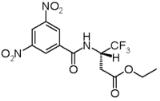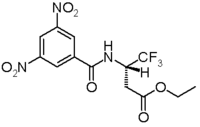
Enantiomer self-disproportionation
Encyclopedia
Enantiomer self-disproportionation is a process in stereochemistry
describing the separation of a non-racemic
mixture of enantiomer
s in an enantioenriched fraction
and a more racemic fraction as a result of the formation of heterochiral or homochiral
aggregates. This process is known to occur in achiral column chromatography
.
The phenomenon was first reported in 1983 in the separation of an excess of
carbon-14
labeled (S)-(−)-nicotine
enantiomer and its isomer. Two fractions were recorded, one containing racemic nicotine and the other pure (S) enantiomer.
In 2006, Vadim A. Soloshonok introduced the term Enantiomer self-disproportionation or self-disproportionation of enantiomers. He investigated achiral separations of several trifluoromethyl compounds.
 By column chromatography on regular silica gel
By column chromatography on regular silica gel
with a hexane
/ ethyl acetate
eluent (5:1), a 66.6% ee
sample of a trifluoromethyl substrate is separated into several fractions ranging from 8.1% ee for the first fraction collected to > 99.9% ee for the last fraction collected. A presence of a strong electronegative
group in the substrate such as the trifluoromethyl group is a prerequisite. The effect disappears when a more polar eluent is selected. A possible explanation is offered. Compounds with large electronegative groups such as trifluoromethyl can form supramolecular associations or aggregates or clusters in which these groups are separated from each other as much as possible with minimized electrostatic repulsions. When these associations are stacks of alternating (R) and (S) molecules (as in syndiotactic polymers) this can be accomplished very efficiently. This association will form a racemic fraction of relatively high molecular weight eluting more slowly than the non-associating enantiopure fraction.
Stereochemistry
Stereochemistry, a subdiscipline of chemistry, involves the study of the relative spatial arrangement of atoms within molecules. An important branch of stereochemistry is the study of chiral molecules....
describing the separation of a non-racemic
Racemic
In chemistry, a racemic mixture, or racemate , is one that has equal amounts of left- and right-handed enantiomers of a chiral molecule. The first known racemic mixture was "racemic acid", which Louis Pasteur found to be a mixture of the two enantiomeric isomers of tartaric acid.- Nomenclature :A...
mixture of enantiomer
Enantiomer
In chemistry, an enantiomer is one of two stereoisomers that are mirror images of each other that are non-superposable , much as one's left and right hands are the same except for opposite orientation. It can be clearly understood if you try to place your hands one over the other without...
s in an enantioenriched fraction
Fraction (chemistry)
A fraction in chemistry is a quantity collected from a sample or batch of a substance in a fractionating separation process. In such a process, a mixture is separated into fractions, which have compositions that vary according to a gradient. A fraction can be defined as a group of chemicals that...
and a more racemic fraction as a result of the formation of heterochiral or homochiral
Homochirality
Homochirality is a term used to refer to a group of molecules that possess the same sense of chirality. Molecules involved are not necessarily the same compound, but similar groups are arranged in the same way around a central atom. In biology homochirality is found in the chemical building blocks...
aggregates. This process is known to occur in achiral column chromatography
Column chromatography
Column chromatography in chemistry is a method used to purify individual chemical compounds from mixtures of compounds. It is often used for preparative applications on scales from micrograms up to kilograms.The main advantage of column chromatography is the relatively low cost and disposability...
.
The phenomenon was first reported in 1983 in the separation of an excess of
carbon-14
Carbon-14
Carbon-14, 14C, or radiocarbon, is a radioactive isotope of carbon with a nucleus containing 6 protons and 8 neutrons. Its presence in organic materials is the basis of the radiocarbon dating method pioneered by Willard Libby and colleagues , to date archaeological, geological, and hydrogeological...
labeled (S)-(−)-nicotine
Nicotine
Nicotine is an alkaloid found in the nightshade family of plants that constitutes approximately 0.6–3.0% of the dry weight of tobacco, with biosynthesis taking place in the roots and accumulation occurring in the leaves...
enantiomer and its isomer. Two fractions were recorded, one containing racemic nicotine and the other pure (S) enantiomer.
In 2006, Vadim A. Soloshonok introduced the term Enantiomer self-disproportionation or self-disproportionation of enantiomers. He investigated achiral separations of several trifluoromethyl compounds.

Silica gel
Silica gel is a granular, vitreous, porous form of silica made synthetically from sodium silicate. Despite its name, silica gel is a solid. It is a naturally occurring mineral that is purified and processed into either granular or beaded form...
with a hexane
Hexane
Hexane is a hydrocarbon with the chemical formula C6H14; that is, an alkane with six carbon atoms.The term may refer to any of four other structural isomers with that formula, or to a mixture of them. In the IUPAC nomenclature, however, hexane is the unbranched isomer ; the other four structures...
/ ethyl acetate
Ethyl acetate
Ethyl acetate is the organic compound with the formula CH3COOCH2CH3. This colorless liquid has a characteristic sweet smell and is used in glues, nail polish removers, and cigarettes...
eluent (5:1), a 66.6% ee
Enantiomeric excess
The enantiomeric excess of a substance is a measure of how pure it is. In this case, the impurity is the undesired enantiomer .-Definition:...
sample of a trifluoromethyl substrate is separated into several fractions ranging from 8.1% ee for the first fraction collected to > 99.9% ee for the last fraction collected. A presence of a strong electronegative
Electronegativity
Electronegativity, symbol χ , is a chemical property that describes the tendency of an atom or a functional group to attract electrons towards itself. An atom's electronegativity is affected by both its atomic number and the distance that its valence electrons reside from the charged nucleus...
group in the substrate such as the trifluoromethyl group is a prerequisite. The effect disappears when a more polar eluent is selected. A possible explanation is offered. Compounds with large electronegative groups such as trifluoromethyl can form supramolecular associations or aggregates or clusters in which these groups are separated from each other as much as possible with minimized electrostatic repulsions. When these associations are stacks of alternating (R) and (S) molecules (as in syndiotactic polymers) this can be accomplished very efficiently. This association will form a racemic fraction of relatively high molecular weight eluting more slowly than the non-associating enantiopure fraction.

